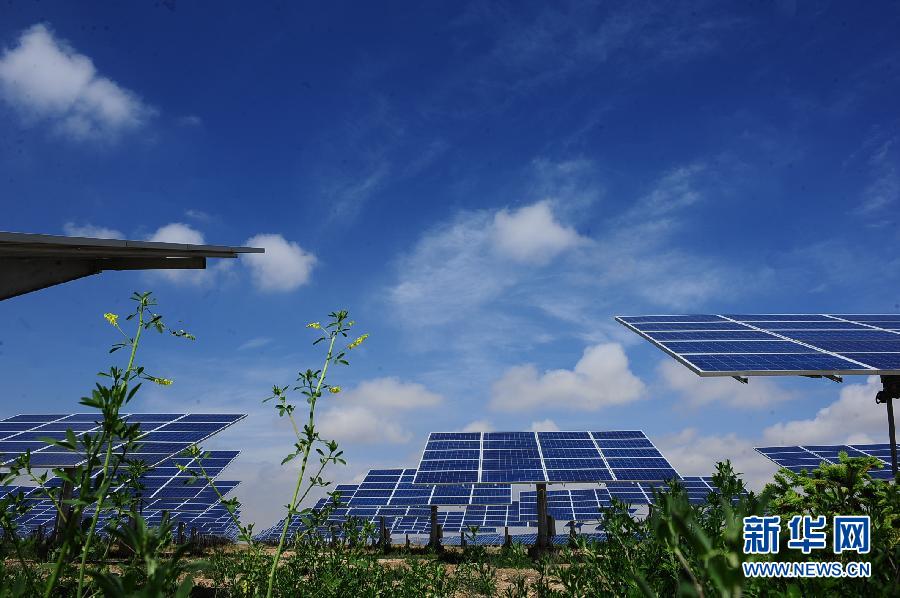

Light blue solar panels gleaming in the sun, water pouring in from the Yellow River to generate electricity in hydropower plants and wind turbines rotating in deserts producing power day and night make for a gorgeous view in northwest China’s Qinghai province.

A photovoltaic power plant located on the grassland in Hainan Tibetan Autonomous Prefecture, Qinghai Province. (Photo/Xinhua)
Clean electricity from renewable energy resources, such as water, wind and solar power, in the plateau province’s Sanjiangyuan area, the source of the Yangtze, Yellow and Lancang Rivers, has helped promote the transformation and upgrading of the province’s industrial structure.
Qinghai has unique advantages in developing clean energy. It has more than 100,000 square kilometers of desertified land that can be used for the construction of photovoltaic power stations and wind farms, as well as more than 3 billion kW of exploitable solar energy and 75 million kW of wind energy.
The Aluminum Corporation of China (Chinalco) Qinghai branch in the province’s capital city Xining is one of the country’s largest electrolytic aluminum enterprises and a major consumer of electricity in the province. Now, clean electricity is being used in the company’s production workshops.
In the past, the electrolytic aluminum industry was labeled a high-pollution sector due to its high energy consumption resulting from the use of thermal power. Extensive production and its negative environmental impact became the main obstacles to the Chinalco Qinghai branch’s development.
“Clean energy has effectively solved these problems, and the traditional industry has embraced green production and operation modes,” said Gong Haijun, a manager at the company, adding that its products have come into high demand after being labeled as products manufactured by green electricity.
In June alone, the company reduced its thermal power consumption by 38 million kWh, which is equivalent to cutting over 4,000 tons of standard coal consumption and reducing carbon dioxide emissions by about 11,000 tons, Gong noted.
With its reserves of lithium resources currently hitting 22.5 million tons, which accounts for over 70 percent of the total in China, Qinghai has also rolled out measures to accelerate the development of the lithium battery sector in recent years.
The province is approaching its target of setting a new record – over 200,000 families and enterprises in the Sanjiangyuan area consisting of 16 counties and one township using only clean electricity for 100 consecutive days from May 9 to August 16. The trial is a testament to Qinghai’s efforts to boost the development of clean energy in recent years.
 Fire brigade in Shanghai holds group wedding
Fire brigade in Shanghai holds group wedding Tourists enjoy ice sculptures in Datan Town, north China
Tourists enjoy ice sculptures in Datan Town, north China Sunset scenery of Dayan Pagoda in Xi'an
Sunset scenery of Dayan Pagoda in Xi'an Tourists have fun at scenic spot in Nanlong Town, NW China
Tourists have fun at scenic spot in Nanlong Town, NW China Harbin attracts tourists by making best use of ice in winter
Harbin attracts tourists by making best use of ice in winter In pics: FIS Alpine Ski Women's World Cup Slalom
In pics: FIS Alpine Ski Women's World Cup Slalom Black-necked cranes rest at reservoir in Lhunzhub County, Lhasa
Black-necked cranes rest at reservoir in Lhunzhub County, Lhasa China's FAST telescope will be available to foreign scientists in April
China's FAST telescope will be available to foreign scientists in April "She power" plays indispensable role in poverty alleviation
"She power" plays indispensable role in poverty alleviation Top 10 world news events of People's Daily in 2020
Top 10 world news events of People's Daily in 2020 Top 10 China news events of People's Daily in 2020
Top 10 China news events of People's Daily in 2020 Top 10 media buzzwords of 2020
Top 10 media buzzwords of 2020 Year-ender:10 major tourism stories of 2020
Year-ender:10 major tourism stories of 2020 No interference in Venezuelan issues
No interference in Venezuelan issues
 Biz prepares for trade spat
Biz prepares for trade spat
 Broadcasting Continent
Broadcasting Continent Australia wins Chinese CEOs as US loses
Australia wins Chinese CEOs as US loses